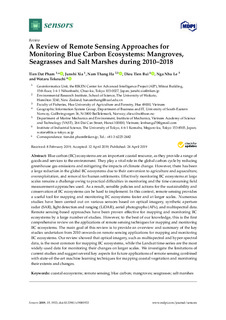| dc.contributor.author | Pham, Tien Dat | |
| dc.contributor.author | Xia, Junshi | |
| dc.contributor.author | Ha, Nam Thang | |
| dc.contributor.author | Tien Bui, Dieu | |
| dc.contributor.author | Le, Nga Nhu | |
| dc.contributor.author | Takeuchi, Wataru | |
| dc.date.accessioned | 2019-11-14T11:40:02Z | |
| dc.date.available | 2019-11-14T11:40:02Z | |
| dc.date.created | 2019-04-19T14:46:55Z | |
| dc.date.issued | 2019 | |
| dc.identifier.citation | Sensors. 2019, 19 (8), 1-37. | nb_NO |
| dc.identifier.issn | 1424-8220 | |
| dc.identifier.uri | http://hdl.handle.net/11250/2628512 | |
| dc.description | Licensee MDPI, Basel, Switzerland. This article is an open access article distributed under the terms and conditions of the Creative Commons Attribution (CC BY) license | nb_NO |
| dc.description.abstract | Blue carbon (BC) ecosystems are an important coastal resource, as they provide a range of goods and services to the environment. They play a vital role in the global carbon cycle by reducing greenhouse gas emissions and mitigating the impacts of climate change. However, there has been a large reduction in the global BC ecosystems due to their conversion to agriculture and aquaculture, overexploitation, and removal for human settlements. Effectively monitoring BC ecosystems at large scales remains a challenge owing to practical difficulties in monitoring and the time-consuming field measurement approaches used. As a result, sensible policies and actions for the sustainability and conservation of BC ecosystems can be hard to implement. In this context, remote sensing provides a useful tool for mapping and monitoring BC ecosystems faster and at larger scales. Numerous studies have been carried out on various sensors based on optical imagery, synthetic aperture radar (SAR), light detection and ranging (LiDAR), aerial photographs (APs), and multispectral data. Remote sensing-based approaches have been proven effective for mapping and monitoring BC ecosystems by a large number of studies. However, to the best of our knowledge, this is the first comprehensive review on the applications of remote sensing techniques for mapping and monitoring BC ecosystems. The main goal of this review is to provide an overview and summary of the key studies undertaken from 2010 onwards on remote sensing applications for mapping and monitoring BC ecosystems. Our review showed that optical imagery, such as multispectral and hyper-spectral data, is the most common for mapping BC ecosystems, while the Landsat time-series, are the most widely used data for monitoring their changes on larger scales. We investigate the limitations of current studies and suggest several key aspects for future applications of remote sensing combined with state-of-the-art machine learning techniques for mapping coastal vegetation and monitoring their extents and changes. | nb_NO |
| dc.description.abstract | A review of remote sensing approaches for monitoring blue carbon ecosystems: Mangroves, seagrasses and salt marshes during 2010 - 2018 | nb_NO |
| dc.language.iso | eng | nb_NO |
| dc.rights | Navngivelse 4.0 Internasjonal | * |
| dc.rights.uri | http://creativecommons.org/licenses/by/4.0/deed.no | * |
| dc.title | A review of remote sensing approaches for monitoring blue carbon ecosystems: Mangroves, seagrasses and salt marshes during 2010 - 2018 | nb_NO |
| dc.type | Journal article | nb_NO |
| dc.type | Peer reviewed | nb_NO |
| dc.description.version | publishedVersion | nb_NO |
| dc.rights.holder | (c) 2019 by the authors. | nb_NO |
| dc.source.pagenumber | 1-37 | nb_NO |
| dc.source.volume | 19 | nb_NO |
| dc.source.journal | Sensors | nb_NO |
| dc.source.issue | 8 | nb_NO |
| dc.identifier.doi | 10.3390/s19081933 | |
| dc.identifier.cristin | 1693215 | |
| cristin.unitcode | 222,57,1,0 | |
| cristin.unitname | Institutt for økonomi og IT | |
| cristin.ispublished | true | |
| cristin.fulltext | original | |
| cristin.qualitycode | 1 | |

